Mutinensis gr. 122
Mutinensis gr. 122 is a 15th-century codex written in Greek, stored in the Biblioteca Estense in Modena, Italy. The designation "Mutinensis gr. 122" is modern, the codex itself bearing the title Epitome of Histories (Greek: Ἐπιτομὴ Ἱστοριῶν)[1] as it contains a copy of the work of the same name by the 12th-century Byzantine historian Joannes Zonaras. Zonaras's work is a chronicle of world history, focusing on the Roman and subsequent Byzantine Empire up until the ascension of Emperor John II Komnenos in 1118. The Modena codex also features additional work by two later scribes, extending the codex to cover Byzantine history after John II up until the Fall of Constantinople in 1453.

The codex is most notable for containing miniature portraits of every Roman emperor from Augustus in 27 BC to Constantine XI Palaiologos in 1453. While portraits of early emperors are likely to be entirely imaginary, portraits of emperors from the 7th century onwards are more reliable (though not naturalistic) and accord well with other sources depicting the same emperors. Some emperors, such as Michael IX (r. 1294/1295–1320) and Andronikos IV (r. 1376–1379) have no known surviving portraits outside of the Modena codex.
Content
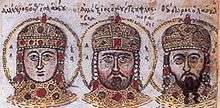
Mutinensis gr. 122 contains a copy of the Epitome of Histories by the 12th-century Byzantine historian Joannes Zonaras, a chronicle of world history, focusing on the Roman and subsequent Byzantine Empire up until the ascension of Emperor John II Komnenos in 1118. The manuscript of the codex has been written by two different hands, with an earlier scribe simply copying the work of Zonaras and a later scribe, working during the second half of the 15th century, expanding the work to include history after the 12th century and writing an introduction to the work. The work of the two different scribes can be distinguished by the later work being written on paper of a different texture and bearing a watermark depicting two scissors.[2] The additions of the second scribe at the end of the work include a list of emperors and their consorts from Alexios I onwards, a list of offices at the Byzantine court, a list of episcopal sees, a list of the Patriarchs of Constantinople, a list of imperial tombs, another list of emperors (this one beginning with Augustus), an account of a statue of Justinian I and portraits of the 24 emperors who reigned after Alexios I.[3]
The most notable feature of the Modena codex is the portraits featured throughout. On the margins of its pages there are portraits depicting every Roman and Byzantine emperor from Augustus in 27 BC to Constantine XI Palaiologos in 1453.[2] The second scribe must have felt that it was important to complete the list and accounts of the emperors and also restored and edited portraits in earlier sections of the manuscript, in addition to creating portraits of the last few emperors.[3] As some portraits, such as the portrait of Claudius (r. 41–54), are uncolored and others are colored in with watercolor, it is likely that the portraits in earlier sections of the work were originally without color, later colored in by the second scribe. The second scribe also wrote over annotations which had faded and added inscriptions beneath some of the portraits in red.[4]
It is clear that the later scribe rearranged parts of the codex. The early and final parts of the earlier scribe's work appear to have been in poor condition, apparently damaged by fire, before the second scribe took to restoring and adding to the codex. The later scribe thus kept the main body of the older codex, restoring some parts (such as the faded portraits), restored some of the lost text and added new text of his own.[5] One of the key pieces of evidence that the codex was not only restored but also rearranged is that some of the portraits presented in the later sections of the work, such as those of emperors Isaac II Angelos (r. 1185–1195, 1203–1204) and John IV Laskaris (r. 1258–1261), appear to have been cut out of earlier portions of the text and pasted in later parts.[4]
The date of the manuscript is not known for certain. The latest portrait pasted from the work of the earlier scribe is the portrait depicting Emperor Manuel II Palaiologos (r. 1391–1425) as an old man with a white beard, meaning that the earlier scribe must have worked at the earliest around year 1425. The later scribe, who ends his gallery of Byzantine imperial portraits with the portraits of Constantine the Great (r. 306–337) and the final emperor, Constantine XI Palaiologos (r. 1448–1453), must have worked at some point after the Fall of Constantinople and the end of the empire, at the earliest in year 1453.[6] The choice to put the portrait of Constantine the Great as the final portrait in the work, after Constantine XI, conveys a prophetic and apocalyptic message. Constantine being featured last might follow the sentiment of the Patriarch of Constantinople in the immediate aftermath of Constantinople's fall, Gennadius Scholarius, who believed the coincidence of the first and last emperor in Constantinople having the name Constantine meant that the end of the world was near. The pictoral sequence in the Modena codex suggests that the second scribe believed that the beginning and the end of the imperial line were indelibly linked.[7]
Analysis of portraits

.jpg)
Although these portraits, especially the portraits depicting more ancient emperors, are often considered imaginary, they compare well to portraits in other, older manuscripts and do carry iconographic value.[2] The portraits are not naturalistic, but prominent features of each emperor, such as the shape or absence of their beards and the shapes of their eyebrows or noses, can be indicate that the creator of the portraits was attempting to faithfully depict the emperors in the manuscript.[8] The many different beards and distinct features of some emperors were not drawn for a sake of variety, but likely based on other then-existing manuscripts or textual sources.[9]
The portraits of the Palaiologan dynasty (the final imperial dynasty, ruling from the 13th to 15th centuries) emperors in the codex accord well with portraits in other sources. In the Modena codex, Michael VIII Palaiologos (r. 1259–1282) is depicted as having a long beard, possibly worn in a net, which is also depicted in other sources for the emperor's appearance, such as a chrysobull in the Vatican Archives and another Medieval manuscript, Monac gr. 442. Michael VIII's son and successor, Andronikos II Palaiologos (r. 1282–1328) is depicted with a wide and square-shaped beard in the codex, a depiction also collaborated by how he is portrayed in chrysobulls and other manuscripts. John VI Kantakouzenos (r. 1347–1354) is also depicted in several portraits in another manuscript, Par. gr. 1242, wherein all portraits show him with a long beard split into two, as in the Modena codex. The portrait of John V Palaiologos (r. 1341–1376, 1379–1390, 1390–1391), showing him as possessing a beard ending in two points, is similar to how the emperor is depicted in the chrysobull of his confession of the Roman Catholic faith (from 1369) and to how he once was depicted on a mosaic in the Hagia Sophia. There are no significant differences between how John VII Palaiologos (r. 1390) is depicted in the Modena codex and how he is depicted in the only other known portrait of the emperor, in the manuscript Par. gr. 1783. The portraits of Manuel II Palaiologos (r. 1391–1425) and John VIII Palaiologos (r. 1425–1448) are considerably similar to portraits in other sources, Manuel always being depicted with a white beard ending in two points and with a long, straight nose and John always possessing a similar beard and an obliquely set nose. The portrait of the final emperor, Constantine XI, is similar to how he is depicted on contemporary seals. The lack of known portraits outside the codex of emperors Michael IX Palaiologos (r. 1294/1295–1320) and Andronikos IV Palaiologos (r. 1376–1379) and the Modena codex's depiction of Andronikos III Palaiologos (r. 1328–1341) being damaged means that their portraits can't be compared to depictions in other sources.[10]
Comparative material is somewhat lacking for the Angelid (12th to 13th centuries) and Laskarid (13th century) dynasties. The Laskarid emperors (with the exception of John IV, who was a child) are all depicted as having peculiar beards with curled ends. On coins, their beards end in two short points, possibly an attempt at depicting something similar, and in another manuscript, Monac. gr. 442, Theodore II Laskaris (r. 1254–1258) is depicted with the same type of beard.[11] Both Isaac II Angelos (r. 1185–1195, 1203–1204) and Alexios III Angelos (r. 1195–1203) are portrayed on their coins as having pointed beards, reflected in the codex's depiction of Isaac II, but the codex depicts Alexios III with a beard cut short. Alexios V Doukas (r. 1204), nicknamed Murtzuphlos in his lifetime due to his bushy eyebrows, is depicted with this signature feature in the Modena codex.[12]
There are several independently created portraits of the emperors of the Komnenid dynasty (11th to 12th centuries), as with the Palaiologan portraits, the portraits in the codex accord well with other portraits of the Komnenid emperors. Alexios I Komnenos (r. 1081–1118) is depicted with a square-shaped beard in the codex, a feature shared with depictions of the emperor in another manuscript, Vat. gr. 666. Alexios I's successor John II Komnenos is represented in the codex with a rounded beard, a feature also reflected in other sources such as a mosaic in the Hagia Sophia and a depiction in the manuscript Vat. Urb. gr. 2. The third Komnenos emperor, Manuel I Komnenos (r. 1143–1180), is depicted with a short beard in his coinage and in the manuscript Vat. gr. 1176, a feature shared by his portrait in the Modena codex. Manuel's heir, the child emperor Alexios II Komnenos (r. 1180–1183) is depicted without a beard and Alexios II's successor, his uncle and the adventurer Andronikos I Komnenos (r. 1183–1185) is depicted as an old man with a long, white beard ending in two points, similar to how he is depicted in his own coins. The shape of the Byzantine imperial crown was changed in the 12th century, gaining a semi-spherical top, which is reflected in portraits of emperors in the codex from John II onwards.[12]
Since the manuscript dates to the 15th century, the portraits of later dynasties are more likely to be reliable than portraits of earlier dynasties.[8] From the 7th century onwards, portraits in the Modena codex are very similar to portraits in other sources. After Heraclius (r. 610–641), the are only two examples of portraits with some minor differences to portraits in other sources, those being the portraits of Basil II (r. 976–1025) and Theophilos (r. 829–842). Portraits before Heraclius are likely to be largely, or entirely, imaginary.[13] For instance, the portrait of Constantine the Great depicts him with a moustache, absent in contemporary depictions of the emperor.[11]
Gallery of portraits

 Constantine I, r. 306–337
Constantine I, r. 306–337.jpg) Maurice, r. 582–602
Maurice, r. 582–602 Leo V, r. 813–820
Leo V, r. 813–820 Romanos I Lekapenos, r. 920–944
Romanos I Lekapenos, r. 920–944 Basil II, r. 976–1025
Basil II, r. 976–1025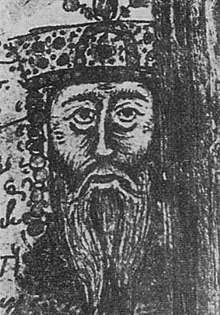 Constantine VIII, r. 976–1028
Constantine VIII, r. 976–1028 Romanos III Argyros, r. 1028–1034
Romanos III Argyros, r. 1028–1034 Michael V Kalaphates, r. 1041–1042
Michael V Kalaphates, r. 1041–1042 Zoë Porphyrogenita, r. 1042
Zoë Porphyrogenita, r. 1042 Theodora III Porphyrogenita, r. 1042, 1055–1056
Theodora III Porphyrogenita, r. 1042, 1055–1056 Constantine IX Monomachos, r. 1042–1055
Constantine IX Monomachos, r. 1042–1055 John II Komnenos, r. 1118–1143
John II Komnenos, r. 1118–1143 Manuel I Komnenos, r. 1143–1180
Manuel I Komnenos, r. 1143–1180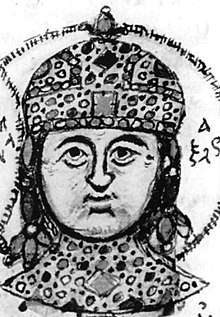 Alexios II Komnenos, r. 1180–1183
Alexios II Komnenos, r. 1180–1183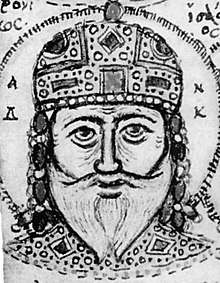 Andronikos I Komnenos, r. 1183–1185
Andronikos I Komnenos, r. 1183–1185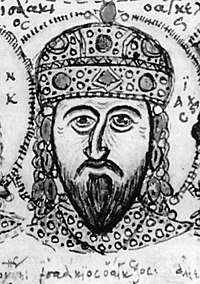 Isaac II Angelos, r. 1185–1195, 1203–1204
Isaac II Angelos, r. 1185–1195, 1203–1204 Alexios III Angelos, r. 1195–1203
Alexios III Angelos, r. 1195–1203.jpg) Alexios IV Angelos, r. 1203–1204
Alexios IV Angelos, r. 1203–1204 Alexios V Doukas, r. 1204
Alexios V Doukas, r. 1204 Theodore I Laskaris, r. 1205–1222
Theodore I Laskaris, r. 1205–1222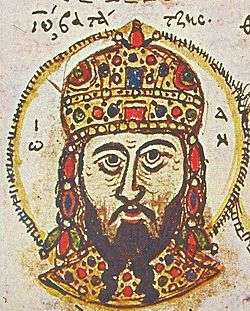 John III Doukas Vatatzes, r. 1222–1254
John III Doukas Vatatzes, r. 1222–1254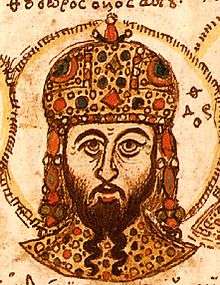 Theodore II Laskaris, r. 1254–1258
Theodore II Laskaris, r. 1254–1258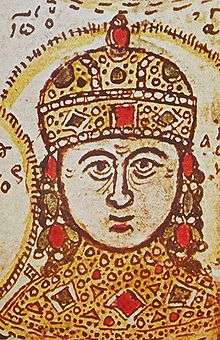 John IV Laskaris, r. 1258–1261
John IV Laskaris, r. 1258–1261 Michael VIII Palaiologos, r. 1259–1282
Michael VIII Palaiologos, r. 1259–1282 Andronikos II Palaiologos, r. 1282–1328
Andronikos II Palaiologos, r. 1282–1328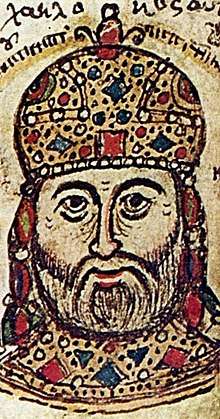 Michael IX Palaiologos, r. 1294/1295–1320
Michael IX Palaiologos, r. 1294/1295–1320.jpg) John V Palaiologos, r. 1341–1376, 1379–1390, 1390–1391
John V Palaiologos, r. 1341–1376, 1379–1390, 1390–1391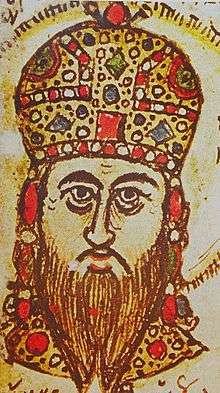 Andronikos IV Palaiologos, r. 1376–1379
Andronikos IV Palaiologos, r. 1376–1379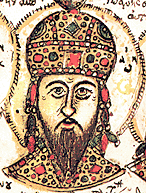 John VII Palaiologos, r. 1390
John VII Palaiologos, r. 1390 Constantine XI Palaiologos, r. 1448–1453
Constantine XI Palaiologos, r. 1448–1453
References
- Ἐπιτομὴ Ἱστοριῶν.
- Spatharákīs 1976, p. 172.
- Spatharákīs 1976, p. 173.
- Spatharákīs 1976, p. 174.
- Spatharákīs 1976, p. 175.
- Spatharákīs 1976, pp. 175–176.
- Mattiello & Rossi 2019.
- Spatharákīs 1976, p. 176.
- Spatharákīs 1976, p. 183.
- Spatharákīs 1976, pp. 176–179.
- Spatharákīs 1976, p. 179.
- Spatharákīs 1976, p. 180.
- Spatharákīs 1976, p. 182.
Cited bibliography
- Mattiello, Andrea; Rossi, Maria Alessia (2019). Late Byzantium Reconsidered: The Arts of the Palaiologan Era in the Mediterranean. Routledge. ISBN 9780815372868.
- Spatharákīs, Iōánnīs (1976). The Portrait in Byzantine Illuminated Manuscripts. Leiden: E. J. Brill. ISBN 9789004047839.
Cited web sources
- "Ἐπιτομὴ Ἱστοριῶν". Ruhr Universität Bochum. Retrieved 10 April 2020.